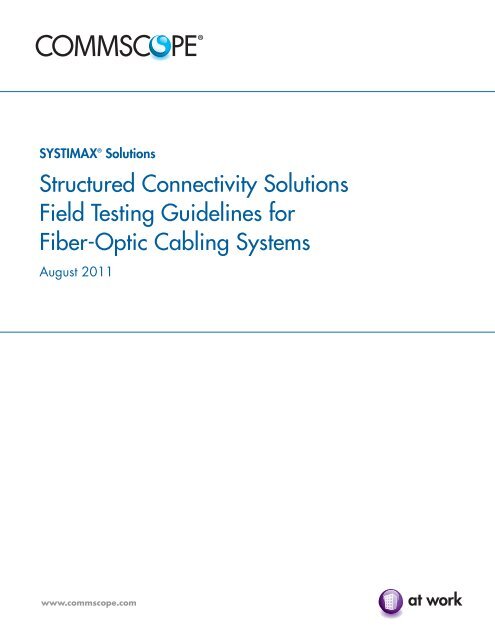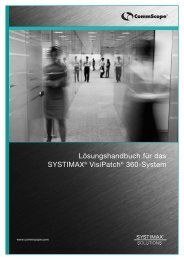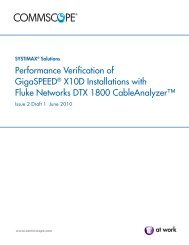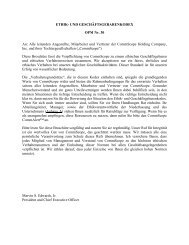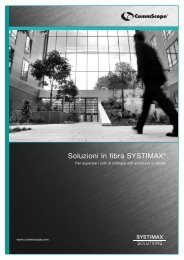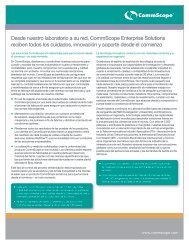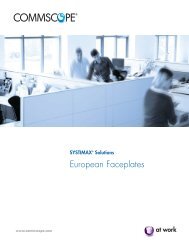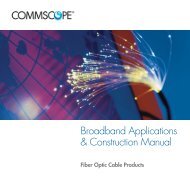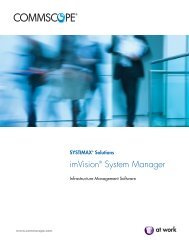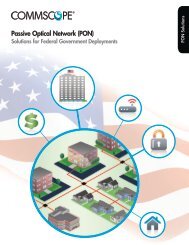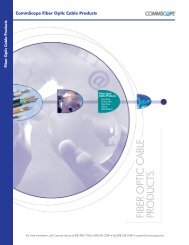Structured Connectivity Solutions Field Testing Guidelines for Fiber ...
Structured Connectivity Solutions Field Testing Guidelines for Fiber ...
Structured Connectivity Solutions Field Testing Guidelines for Fiber ...
You also want an ePaper? Increase the reach of your titles
YUMPU automatically turns print PDFs into web optimized ePapers that Google loves.
SYSTIMAX ®<br />
<strong>Solutions</strong><br />
<strong>Structured</strong> <strong>Connectivity</strong> <strong>Solutions</strong><br />
<strong>Field</strong> <strong>Testing</strong> <strong>Guidelines</strong> <strong>for</strong><br />
<strong>Fiber</strong>-Optic Cabling Systems<br />
August 2011<br />
www.commscope.com
Contents<br />
Contents 2<br />
1. Introduction 1<br />
2. Passive Link Segments 2<br />
3. General <strong>Testing</strong> <strong>Guidelines</strong> 3<br />
4. Acceptable Attenuation Values 5<br />
5. <strong>Testing</strong> Procedure <strong>for</strong> Single <strong>Fiber</strong> Connector <strong>Solutions</strong> 6<br />
5.1 Test Jumper Per<strong>for</strong>mance Verification 7<br />
5.1.1 Case 1: Matching Connector Types 7<br />
5.2 Link Segment <strong>Testing</strong> 9<br />
5.2.1 Case 1: Matching Connector Types 9<br />
5.2.2 Case 2: Differing Connector Types. Between Test Equipment and Cabling 10<br />
5.3 TIA and ISO/IEC Standards 11<br />
6.1 MPO Case 1: Link with an MPO Trunk Connected to MPO to LC (or SC, ST)<br />
Modules on Each End 12<br />
6. <strong>Testing</strong> Procedure <strong>for</strong> <strong>Solutions</strong> Utilizing MPO <strong>Connectivity</strong> 12<br />
6.2 MPO Case 2: MPO Trunk Cable <strong>Testing</strong> Only For 40/100G Applications<br />
or When MPO-LC Harnesses Will be Connected at a Later Date 14<br />
7. <strong>Testing</strong> Procedure - MPO <strong>Solutions</strong> 15<br />
7.1 Cable Plant Defect Detection and Resolution 15<br />
7.2 Test Equipment Checklist 16<br />
Appendix A 17<br />
Appendix B 19<br />
Mandrel Wrap Prescriptions 19<br />
Appendix C: Encircled Flux Control (Optional <strong>for</strong> <strong>Field</strong> <strong>Testing</strong>) 20<br />
Test Instrument Data Sheet 21<br />
Link Attenuation Measurement Record <strong>for</strong> Power Meters Displaying<br />
Absolute Power Levels 22<br />
Link Attenuation Measurement Record <strong>for</strong> Power Meters Displaying<br />
Absolute Power Levels 23<br />
www.commscope.com 2
1. Introduction<br />
The following guidelines describe SYSTIMAX ®<br />
<strong>Solutions</strong>’ recommended procedure <strong>for</strong> field<br />
testing multimode and singlemode cabling systems. SYSTIMAX <strong>Solutions</strong> TM<br />
only requires testing<br />
of link attenuation <strong>for</strong> Enterprise networks. While other fiber-optic cabling system parameters<br />
such as bandwidth are equally important, they are not normally affected by the quality of<br />
the installation and there<strong>for</strong>e, do not require field testing. This document describes how and<br />
where attenuation testing should be per<strong>for</strong>med For enterpise systems. TIA-568C.0 ANNEX E<br />
(In<strong>for</strong>mative) <strong>Guidelines</strong> For <strong>Field</strong>-<strong>Testing</strong> Length, Loss And Polarity Of Optical <strong>Fiber</strong> Cabling<br />
provides guidelines <strong>for</strong> testing optical fiber systems. Optical loss (link attenuation), length<br />
verification, and polarity testing are defined here as Tier 1 testing, while OTDR testing is a Tier<br />
2 and optional test. This document replaces the previous revision dated March 2005.<br />
www.commscope.com 1
2. Passive Link Segments<br />
Attenuation testing should be per<strong>for</strong>med on each passive link segment of the cabling system.<br />
A link segment consists of the cable, connectors, couplings, and splices between two fiberoptic<br />
termination units (patch panels, in<strong>for</strong>mation outlets, etc.). Each terminated fiber within<br />
a link segment should be tested. The link segment attenuation measurement includes the<br />
representative attenuation of connectors at the termination unit interface on both ends of the<br />
link, but does not include the attenuation associated with the active equipment interface.<br />
This is illustrated in Figure 1.<br />
Figure 1. Tested Link Segment<br />
There are three basic types of link segments described in this document: horizontal, backbone,<br />
and composite. A horizontal link segment normally begins at the telecommunications outlet and<br />
ends at the horizontal cross-connect. The telecommunications outlet may be a multi-user outlet<br />
placed in an open office area. The horizontal link segment may also include a consolidation<br />
point interconnection or a transition point splice. A riser backbone link segment usually begins<br />
at the main cross-connect and ends at the horizontal cross-connect. For the purposes of this<br />
document, a tie cable (placed between two horizontal cross-connects) and a campus cable<br />
(typically placed between two main cross-connects) are both considered backbone link<br />
segments. Single Point Administration architecture (i.e. Centralized Cabling) eliminates the<br />
horizontal cross-connect, and there<strong>for</strong>e horizontal and backbone cabling are combined into a<br />
composite link segment. In this case, the horizontal closet may contain a splice, interconnect,<br />
or pulled-through cable.<br />
Note: Spliced pigtail terminations at one or both ends of a horizontal, backbone, or composite link are permitted.<br />
www.commscope.com 2
3. General <strong>Testing</strong> <strong>Guidelines</strong><br />
SAFETY NOTE: Unterminated connectors may emit radiation if the far end is connected to a laser<br />
or LED. Do not view the end of a cable until absolutely sure that the fiber is disconnected from<br />
any laser or LED source. The best practice would be to only view the end face of a connector<br />
through a scope and view, so that no direct eye contact is possible the laser light. Today’s<br />
inspection kits are available to view multifiber MPO connectors as well as single-fiber types.<br />
• Multimode horizontal link segments should be tested in one direction at EITHER 850 nm<br />
or 1300 nm wavelength.<br />
• Multimode backbone and composite link segments should be tested in one direction at<br />
850 nm and 1300 nm wavelengths.<br />
• Singlemode horizontal link segments should be tested in one direction at EITHER 1310 nm<br />
or 1550 nm wavelength.<br />
• Singlemode backbone and composite link segments should be tested in one direction at<br />
BOTH 1310 nm and 1550 nm wavelengths.<br />
Note 1: Horizontal link segments are short enough that attenuation differences caused by<br />
wavelength are insignificant. As a result, single wavelength testing is sufficient. Backbone and<br />
composite links may be longer, and attenuation may strongly depend on wavelength in such<br />
links. There<strong>for</strong>e, it is necessary to test at both wavelengths.<br />
Note 2: The minor attenuation differences due to test direction are on par with the accuracy<br />
and repeatability of the test method. There<strong>for</strong>e, testing in only one direction normally suffices.<br />
However, test in both directions if the installation contains fibers of different core sizes. This is<br />
to detect inadvertent mixing of fibers with different core sizes, as the loss in one direction will<br />
differ from the loss in the other direction by at least 2 dB if different core sizes are connected<br />
together (e.g. 50 µm connected to 62.5 µm) when measured using 62.5 µm test jumpers.<br />
Note 3: Today’s standards only ask <strong>for</strong> uni-directional OLTS testing, however many customers<br />
are requesting bi-directional results. While bi-directional OLTS testing may provide more data,<br />
there is a trade-off with the extra time required and the additional opportunity <strong>for</strong> dirt and dust<br />
to be introduced during the testing process. Bi-directional test results are optional; if used, the<br />
direction with the higher loss measurement would be used to determine pass/fail <strong>for</strong> the link.<br />
SYSTIMAX <strong>Solutions</strong> requires multimode field tests to be per<strong>for</strong>med with a launch condition as<br />
defined in TIA-526-14B. Defining a particular launch condition reduces measurement error<br />
and variability. This particular launch will produce field measurements that correlate well with<br />
component specifications. This launch condition can be closely and easily approximated in the<br />
field by using a Category 1 Coupled Power Ratio (CPR) source with a specific mandrel wrap<br />
on the launch test jumper. TIA-526-14B describes the test procedure to categorize the CPR of<br />
a multimode light source, with instructions on creating the proper mandrel wrap.<br />
www.commscope.com 3
In compliance with TIA/EIA-526-14B “Optical Power Loss Measurements of Installed<br />
Multimode <strong>Fiber</strong> Cable Plant”, IEC 61280-4-1 edition 2, Fibre-Optic Communications<br />
Subsystem Test Procedure – 49 Part 4-1: Installed cable plant – Multimode attenuation<br />
measurement – OFSTP-14, TIA/EIA-526-7 “Measurement of Optical Power Loss of Installed<br />
Singlemode <strong>Fiber</strong> Cable Plant”, and IEC 61280-4-2 ed 1 Fibre optic cable plant - Singlemode<br />
fibre optic cable plant attenuation the following in<strong>for</strong>mation should be recorded during<br />
the test procedure:<br />
1. Names of personnel conducting the test.<br />
2. Type of test equipment used (manufacturer, model, and serial number).<br />
3. Date test is being per<strong>for</strong>med.<br />
4. Optical source wavelength, spectral width, and CPR (<strong>for</strong> multimode tests only).<br />
5. <strong>Fiber</strong> identification.<br />
6. End point locations.<br />
7. Test direction.<br />
8. Reference power measurement (when not using a power meter with a Relative Power<br />
Measurement Mode).<br />
9. Measured attenuation of the link segment.<br />
10. Acceptable link attenuation.<br />
Note: Horizontal link segments are often all within 90 meters; there<strong>for</strong>e, the acceptable link attenuation can be<br />
based on the longest installed link without introducing a significant error in cases where this shorter distance is<br />
maintained 100%. However, if the design calls <strong>for</strong> horizontal runs of longer than 90 meters, than there would likely<br />
be more variation and it would not be as accurate to use only the longest run to estimate loss.<br />
See the end of this document <strong>for</strong> sample measurement recording <strong>for</strong>ms.<br />
IMPORTANT NOTE: Ensure that all connectors/modules are cleaned prior to mating trunk<br />
cables or patch cords.<br />
Contamination as small as 0.001 mm can block the fiber core generating strong back<br />
reflections (Return Loss) and may effect attenuation (Insertion Loss). Mating a contaminated<br />
connector to a clean connector will result in poor per<strong>for</strong>mance and can permanently damage<br />
the connection. CommScope recommends that fiber optic connectors are inspected with a<br />
microscope prior to mating.<br />
Please refer to the CommScope <strong>Fiber</strong> Optic Connector and Adapter Cleaning Procedures<br />
and the CommScope <strong>Fiber</strong> Optic Connector Cleaning and Inspection kit <strong>for</strong> more detailed<br />
in<strong>for</strong>mation. Also refer to Section 7.<br />
www.commscope.com 4
4. Acceptable Attenuation Values<br />
OLTS testing is used to evaluate the overall loss of an entire optical link. Although individual<br />
component specifications can be reviewed on each component’s specification sheet, simply<br />
adding these values together would likely overestimate the loss of that link. CommScope<br />
provides a link loss calculator that can be used to determine the maximum acceptable loss<br />
<strong>for</strong> each link evaluated.<br />
In<strong>for</strong>mation to be entered into the link loss calculator:<br />
1. <strong>Fiber</strong> type<br />
2. <strong>Fiber</strong> length in feet or meters<br />
3. Wavelength tested<br />
4. Connector types<br />
5. Number of connections<br />
The attenuation <strong>for</strong> any link segment can be calculated using the latest version of<br />
the CommScope <strong>Fiber</strong> LinkLoss Calculator. This calculator can be downloaded from<br />
mycommscope.com website or please consult your local CommScope representative.<br />
An example of the <strong>for</strong>mat <strong>for</strong> the <strong>Fiber</strong> LinkLoss Calculator, available at www.mycommscope.com,<br />
is given in Figure 2.<br />
Figure 2<br />
A connection is defined by the joint made by mating 2 fibers terminated with rematable<br />
connectors (LC, SC, MPO, etc). For example, an LC connector pair made up of 2 connectors,<br />
would count as only 1 connection within the link loss calculator.<br />
When using the InstaPATCH 360 module, each module actually contains two (2) connection<br />
points. This equates to 1 x LC/SC/ST and 1 x MPO per module <strong>for</strong> the <strong>Fiber</strong> LinkLoss<br />
Calculator.<br />
The value provided is the maximum acceptable loss that is allowable to ensure that the solution<br />
will meet the per<strong>for</strong>mance as described in the CommScope Per<strong>for</strong>mance Specifications guides.<br />
Note that this loss will likely be LESS than would be defined by TIA and I EC standards.<br />
Additionally, this value will also likely be LESS than would be calculated by adding the<br />
potential loss of all individual components together.<br />
www.commscope.com 5
5. <strong>Testing</strong> Procedure <strong>for</strong> Single<br />
<strong>Fiber</strong> Connector <strong>Solutions</strong><br />
The basic steps <strong>for</strong> per<strong>for</strong>ming field attenuation measurements are:<br />
1. verify test jumper per<strong>for</strong>mance (see section 5.1),<br />
2. obtain a reference power level (see section 5.2),<br />
3. measure link power throughput (see section 5.2),<br />
4. calculate and record link attenuation (see section 5.2).<br />
Two worksheets in the back of these guidelines may be used <strong>for</strong> recording measurement<br />
in<strong>for</strong>mation. The first is <strong>for</strong> use with power meters that display absolute power levels without<br />
a selectable reference. The second is <strong>for</strong> power meters that display power levels relative to a<br />
measured reference level. Of course today most test sets will allow the user to record the data<br />
within the test units to later access electronically. This is the preferred method of record keeping.<br />
If the power meter supports measurements relative to a previously made reference measurement<br />
(in units of dB), select this mode, as such readings do not necessitate manual calculation. If the<br />
meter does not have a Relative Power Measurement mode, per<strong>for</strong>m the following calculation to<br />
determine attenuation:<br />
• If P sum and P ref are in the same logarithmic units (dBm, dBu, etc.):<br />
Attenuation (dB) = | P sum /P ref |<br />
• If P sum and P ref are in the same linear units (watts, milliwatts (mw), mircowatts (µw)):<br />
Attenuation (dB) = | 10 x LOG10 [P sum /P ref ]|<br />
Where: P sum is the power reading of the item under test,<br />
P ref is the power level of the reference measurement.<br />
Caution: Stable reference power levels are critical to the accuracy of subsequent attenuation<br />
measurements. Instability may arise from at least two common causes: battery health and<br />
mechanical changes at the connection to the source. Ensure the battery is in good operating<br />
condition and fully charged in both the source and power meter. Avoid disturbing in any way<br />
the connection from the source to the test jumper after the reference measurement. Disturbances<br />
include disconnection, lateral side-loading, and axial tension. Any of these disturbances<br />
is cause <strong>for</strong> making a new reference measurement. The chances <strong>for</strong> encountering these<br />
disturbances may be minimized by securing the launch test jumper to the source test set by<br />
means of tape or cable tie applied at the mandrel or mode suppression loop (described later).<br />
SYSTIMAX <strong>Solutions</strong> requires all multimode jumper per<strong>for</strong>mance verifications and link attenuation<br />
measurements to be per<strong>for</strong>med with a launch condition as defined in TIA-526-14B. This launch<br />
condition can be approximated in the field by using a Category 1 CPR source with a specific<br />
mandrel wrap on the launch test jumper. Refer to Appendix A <strong>for</strong> instructions on measuring the<br />
CPR of the light source. Refer to Appendix B <strong>for</strong> instructions on creating the proper mandrel wrap.<br />
Category 1 CPR sources are generally LEDs (Light Emitting Diodes).<br />
Caution: CommScope does not recommend the use of Vertical Cavity Surface Emitting Laser<br />
(VCSEL)-based light sources as the primary light source <strong>for</strong> testing multimode fiber links. This is due<br />
to the fact that there is a large variability in VCSEL launch conditions that may lead to significant<br />
measurement variability. This variability also diminishes any correlation to the attenuation seen by<br />
VCSEL-based applications. In addition VCSEL-based sources do not normally produce Category 1<br />
CPR. Use of a Category 1 CPR source with a mandrel wrapped test jumper provides a standard<br />
launch condition that strikes a good balance between LED and VCSEL-based application needs<br />
while reducing measurement variability, increasing measurement repeatability and improving<br />
agreement between different test sets. There<strong>for</strong>e the mandrel-wrapped Category-1 CPR launch<br />
condition is required <strong>for</strong> baseline attenuation measurements. VCSEL-based launch conditions may<br />
be added as supplemental in<strong>for</strong>mation, but the results may be over-optimistic, even if the cable<br />
plant is intended to support VCSEL-based applications.<br />
www.commscope.com 6
SYSTIMAX <strong>Solutions</strong> requires all singlemode jumper per<strong>for</strong>mance verifications and link<br />
attenuation measurements to be per<strong>for</strong>med with a launch test jumper containing a single loop<br />
< 30 mm (1.2 inches) in diameter to suppress multimode propagation. This loop may be<br />
created by either wrapping the jumper around a mandrel or in free space by securing the<br />
jumper to itself.<br />
5.1 Test Jumper Per<strong>for</strong>mance Verification<br />
In compliance with TIA/EIA-526-14B and TIA/EIA-526-7 (and IEC equivalents), test jumpers<br />
shall be 1 - 5 meters long, and have the same fiber construction (i.e. core diameter and<br />
numerical aperture) as the link segment being tested. Be<strong>for</strong>e carrying out any test, clean the<br />
test jumper connectors and test coupling.<br />
Follow the procedure <strong>for</strong> one of the following two cases that corresponds to the particular<br />
cable plant and test set connector types. Follow section 5.1.1 in cases where the connector<br />
type on the cable plant matches that of the test set.<br />
5.1.1 Case 1: Matching Connector Types<br />
Procedure:<br />
1. Prepare the required launch test jumper (test jumper-1) with the necessary mandrel wrap<br />
<strong>for</strong> multimode measurements or mode suppression loop <strong>for</strong> singlemode measurements.<br />
2. Clean all test jumper connectors and the test coupling per the manufacturer’s instructions.<br />
3. Follow the test equipment manufacturer’s initial adjustment instructions.<br />
4. Connect test jumper-1 between the light source and the power meter. See Figure 4.<br />
Figure 3<br />
Light<br />
Source<br />
Test Jumper-1<br />
TX RX<br />
Mandrel Wrap<br />
Power<br />
Meter<br />
5. Record the Reference Power Measurement (Pref) or, preferably, select the power meter’s<br />
Relative Power Measurement Mode.<br />
6. Disconnect test jumper-1 from the power meter.<br />
7. Connect test jumper-2 between the power meter and test jumper-1 using the test coupling.<br />
See Figure 5.<br />
www.commscope.com 7
Figure 4<br />
Light<br />
Source<br />
TX<br />
Test Jumper-1 Test Jumper-2<br />
Mandrel Wrap<br />
Coupling<br />
(Adapter)<br />
8. Record the Power Measurement (Psum). Per<strong>for</strong>m the calculations given in section 5 if not<br />
using Relative Power Measurement mode. This measurement provides the attenuation of the<br />
cable of test jumper-2 plus the connection between test jumper-1 and test jumper-2. The<br />
measured attenuation must be less than or equal to the corresponding value given in Table<br />
4. Unacceptable attenuation measurements may be attributable to either of the test jumpers.<br />
Examine each jumper with a portable microscope and clean, polish, or replace if necessary.<br />
9. Flip the ends of test jumper-2 so that the end connected to the power meter is now connected<br />
to the coupling, and the end connected to the coupling is now connected to the power meter.<br />
10. Record the new Power Measurement (Psum). Per<strong>for</strong>m the calculations given in section 5 if<br />
not using Relative Power Measurement Mode. The attenuation must be less than or equal<br />
to the corresponding value found in Table 4.<br />
TABLE 4 ACCEPTABLE TEST JUMPER ATTENUATION<br />
<strong>Fiber</strong> Type Connection Type Between Test Jumpers<br />
ST or SC LC<br />
Power<br />
Meter<br />
62.5 µm Multimode 0.50 dB Max 0.20 dB Max<br />
LazrSPEED 50 µm 0.50 dB Max 0.28 dB Max<br />
Singlemode 0.55 dB Max 0.30 dB Max<br />
If both measurements are found to be less than or equal to the values found in Table 4, test<br />
jumper-2 is acceptable <strong>for</strong> testing purposes.<br />
11. Repeat this test procedure from the beginning reversing jumper-1 and jumper-2 in order to<br />
verify the per<strong>for</strong>mance of test jumper-1. Remember to remove the existing mandrel or loop<br />
from <strong>for</strong>mer test jumper-1 and apply the same to new test jumper-1 (<strong>for</strong>mer test jumper-2).<br />
RX<br />
www.commscope.com 8
5.2 Link Segment <strong>Testing</strong><br />
In order to include all connections in the measurement, the One Reference Jumper Method<br />
specified in TIA/EIA-526-14B (<strong>for</strong> multimode fibers) and TIA/EIA-526-7 (<strong>for</strong> singlemode<br />
fibers) shall be used to test each link segment. This procedure, adapted to address two cases,<br />
is summarized in the next two sections. Follow section 5.2.1 in cases where the connector<br />
type on the cable plant matches that of the test set. Follow section 5.2.2 <strong>for</strong> cases where the<br />
connector type on the cable plant differs from that on the test set.<br />
5.2.1 Case 1: Matching Connector Types<br />
Procedure:<br />
1. Use known-good test jumpers, each verified by following the procedure in section 5.1.1.<br />
2. Prepare the required launch test jumper (test jumper-1) with the necessary mandrel wrap<br />
<strong>for</strong> multimode measurements or mode suppression loop <strong>for</strong> singlemode measurements<br />
(Test Jumper-1 in Figure 8).<br />
3. Clean the test jumper connectors per the manufacturer’s instructions.<br />
4. Follow the test equipment manufacturer’s initial adjustment instructions.<br />
5. Connect test jumper-1 between the light source and the power meter. See Figure 8.<br />
Figure 5<br />
Light<br />
Source<br />
Test Jumper-1<br />
TX RX<br />
Mandrel Wrap<br />
Power<br />
Meter<br />
6. Record the Reference Power Measurement (Pref) or, preferably, select the power meter’s<br />
Relative Power Measurement Mode.<br />
7. Disconnect jumper-1 from the power meter and connect it to test jumper-2. Do NOT<br />
disconnect the test jumper from the light source. Connect the other side of jumper-2 to<br />
the meter port. Verify that the connector loss is at or below the value shown in Table 4<br />
above.<br />
8. Separate jumper-1 from jumper 2 and connect to the ends of the system under test.<br />
DO NOT make any disconnections at the source or meter ports. Connect test jumper-2<br />
between the other end of the link segment and the power meter. Verify the loss is equal to<br />
or less than the value shown in the link loss calculator.<br />
www.commscope.com 9
Figure 8<br />
Test Jumper-1 LINK SEGMENT<br />
Test Jumper-2<br />
Light<br />
Power<br />
TX RX<br />
Source<br />
Meter<br />
Mandrel<br />
Wrap<br />
Splice<br />
Interconnection<br />
Termination Unit:<br />
Patch Panel, Faceplate, etc.<br />
w/Coupling<br />
9. Record the Power Measurement (P sum ). Per<strong>for</strong>m the calculations given in section 5 if not<br />
using Relative Power Measurement mode. This measurement provides the attenuation of<br />
the link segment cable(s), splice(s) and connections, including the connections on its ends.<br />
If the measurement value is less than or equal to the value calculated using the attenuation<br />
equation (see section 4), the link segment attenuation is acceptable. If not acceptable see<br />
section 6 <strong>for</strong> troubleshooting guidance.<br />
5.2.2 Case 2: Differing Connector Types. Between Test Equipment and Cabling<br />
The One Jumper Reference Method in TIA/EIA-526-14B (<strong>for</strong> multimode fibers) and TIA/EIA-<br />
526-7 (<strong>for</strong> singlemode fibers) assumes the test equipment to have the same connector type as in<br />
the link under test. The three reference jumper test method outlined in the previous CommScope<br />
<strong>Fiber</strong> <strong>Testing</strong> <strong>Guidelines</strong> (dated March 2005, section 5.2.2) is no longer needed, except<br />
when testing InstaPATCH trunk cables only (see section 6). This modified adaptation method is<br />
necessary when the optical power loss meter receptacle did not mate with the connector of the<br />
installed cabling.<br />
Today’s equipment should have a meter port that can be replaced to match the field connector.<br />
This will allow the technician to adjust the connector types as needed to provide a true<br />
1-jumper reference. Follow the procedures outlines in 5.2.1, changing out the meter port as<br />
required to have the appropriate connector type.<br />
Hence, starting 15th October 2004, CommScope requires the use of optical power loss<br />
meters directly compatible with the cabling plant. Some manufacturers and their products that<br />
offer this feature are:<br />
• AFL (alcoa.com/afl_tele): MLP, SLP series<br />
• Exfo (exfo.com): FOT-920<br />
• Fluke (flukenetworks.com): Certifiber, Simplefiber, DTX-1800 CableAnalyser (with DTX-MFM2<br />
fiber modules and NFA-LC adapters)<br />
Note that the cord on the source side is not removed and there<strong>for</strong>e the source port does not<br />
need to be adjustable. A cord with different connector types on each end may be needed here<br />
to connect to the source port and the field connector.<br />
www.commscope.com 10
Figures 7 and 8 show the test set-up to evaluate an optical link with LC connections and<br />
LC-SC patch cords when the test equipment provided has an SC optical source port and an<br />
adjustable meter port.<br />
Figure 7 - Reference set-up<br />
5.3 TIA and ISO/IEC Standards<br />
ISO/IEC 14763-3 covers ‘Implementation and Operation of Customer Premises Cabling:<br />
<strong>Testing</strong> of Optical <strong>Fiber</strong> Cabling’ and references<br />
• IEC 61280-4-1 <strong>for</strong> installed multimode fiber optic cable plant attenuation measurement<br />
• IEC 61280-4-2 <strong>for</strong> installed singlemode fiber optic cable plant attenuation measurement<br />
Besides the TIA/EIA-526-14B and TIA/EIA-526-7 standards already discussed, TIA568C.0<br />
and C.1 covers ‘additional guidelines <strong>for</strong> field testing length, loss and polarity of optical fiber<br />
cabling systems’.<br />
Table 2 provides the link configurations and the associated reference test methods required by<br />
the different standards.<br />
TABLE 2 - LINk CONFIGURATIONS AND THE ASSOCIATED REFERENCE TEST METHODS<br />
Link Configurations<br />
(Numberof connections<br />
included inloss measurement)<br />
Common<br />
Terminology<br />
1-Jumper Reference<br />
Photos courtesy of Fluke ®<br />
Network<br />
1. Disconnect from Meter Port<br />
2. Add Test Jumpers at the<br />
Meter and validate mating<br />
3. Test the system<br />
TIA/EIA-526-14B<br />
(Multimode)<br />
TIA/EIA-526-7<br />
(Singlemode)<br />
Meter port adapters should be<br />
interchangeable <strong>for</strong> ease of<br />
referencing and testing<br />
<strong>Testing</strong> an LC system with LC-SC<br />
duplex Jumpers:<br />
•LC port needed <strong>for</strong> referencing<br />
•SC port needed <strong>for</strong> testing<br />
Figure 8 - System Test<br />
Photos courtesy of Fluke ®<br />
Network<br />
IEC 61280-4-1<br />
(Multimode)<br />
IEC 61280-4-2<br />
(Singlemode)<br />
1 2-jumper method Method A Method A.2 Annex C Method A.2<br />
2 (i.e. panel-to-panel links) 1-jumper method Method B Method A.1 Annex A Method A.1<br />
2 (Adaptation) 3-jumper method Method C Method A.3 Annex B Method A.3<br />
The CommScope testing guidelines are in accordance with TIA and IEC 61280-4 series of<br />
standards. The 1-jumper method is the most conservative and commonly used. Technicians<br />
should default to using the 1-jumper reference method in almost all cases.<br />
Note that Optical Time Domain Reflectometer (OTDR) test is optional <strong>for</strong> CommScope.<br />
www.commscope.com 11
6. <strong>Testing</strong> Procedure <strong>for</strong> <strong>Solutions</strong><br />
Utilizing MPO <strong>Connectivity</strong><br />
With the inevitable migration to applications using parallel optics technologies such as<br />
40G/100G Ethernet, there is a need to test link segments consisting of MPO array cabling,<br />
as seen within the CommScope InstaPATCH 360 solution. The MPO connector allows <strong>for</strong><br />
the consolidation of many fibers within one array. Although typically provided with 12 fibers,<br />
an MPO may house 8 or 24 fibers less commonly, with other values of fibers possible. The<br />
discussion and figures will focus on 12-F MPO solutions, but the process is relevant to the others.<br />
6.1 MPO Case 1: Link with an MPO Trunk Connected<br />
to MPO to LC (or SC, ST) Modules on Each End<br />
In this case, the link can be tested through the single-fiber connections and the testing process<br />
will not significantly change. The technician can follow the procedures outlined in section 5.<br />
As you can see in figure 9, the MPOs are behind the wall and not connected directly to the<br />
test cords. If testing 2 fibers at a time, the technician could test all 12 fibers of the MPO link<br />
with 6 individual tests.<br />
Figure 9<br />
400 m (1312 ft)<br />
Courtesy of Fluke ®<br />
Network<br />
www.commscope.com 12
Figure 10 MPO-LC harnesses may take the place of MPO-LC modules and LC<br />
duplex patch cords<br />
The extra connector pairs do need to be accounted <strong>for</strong> within the link loss calculator however.<br />
An MPO to LC (or SC, ST) module will count as 2 connections on each side. The MPO and<br />
single-fiber connections make separate connections. The user should add 1 connection <strong>for</strong> both<br />
the single-fiber and MPO connector within the link loss calculator. In contrast, use of an MPO to<br />
single-fiber array cord (figure 10) will likely only count as 1 MPO connection, as the single-fiber<br />
connector will likely be plugged directly into the electronics.<br />
In the test shown in figure 9 above, there are 2 MPO connections and 2 LC connections. An<br />
example of how the link loss calculator can be used to determine the maximum loss <strong>for</strong> this link<br />
is show in figure 11.<br />
Figure 11<br />
www.commscope.com 13
Photos courtesy of Fluke ®<br />
Network<br />
6.2 MPO Case 2: MPO Trunk Cable <strong>Testing</strong> – For<br />
40/100G Applications or When MPO-LC Harnesses<br />
Will be Connected at a Later Date<br />
In this case, there are no single-fiber connectors to attach traditional single-fiber test cords to.<br />
In a laboratory setting, there would be test equipment available that could directly to MPO<br />
connectors. This would require a mix of 12 output sources and either 12 input ports or an<br />
MPO port with a very wide area adapter to accept the light from all 12 (or 24 fibers). This<br />
set-up is fairly impractical <strong>for</strong> field-testing today.<br />
Instead, the technician should use an MPO to LC break-out patch cord to separate the trunk<br />
into single-fiber channels <strong>for</strong> testing. Because of the additional cords, a 3-jumper reference is<br />
required to account <strong>for</strong> the additional loss of test connections.<br />
The basic steps <strong>for</strong> per<strong>for</strong>ming field attenuation measurements of an MPO trunk are:<br />
1. Verify test jumper per<strong>for</strong>mance (see section 5.1),<br />
2. Obtain a reference power level (Fig X1, X2, X3). There should >= 0.1 dB of power<br />
difference between X1 and X2, X2 and<br />
3. Reference the unit to 0.0 dBr with the 3 LC patch cords in place<br />
4. Remove the middle patch cord and add an LC to MPO array cord on each side (FigX4)<br />
5. Attach the MPO-LC cords to the MPO trunk and measure the loss at the first LC duplex<br />
6. Record and measure the loss at the 2nd LC duplex and continue to the last connection<br />
Figure 12<br />
Note: EVERY test must measure at or below the maximum value obtained in the link loss calculator in order <strong>for</strong> the<br />
entire MPO link to be acceptable. Even one value above the maximum allowable loss would cause the entire link to<br />
be considered a failure.<br />
Section 7 refers to contamination and cleaning procedures. MPO solutions are particularly<br />
susceptible to contamination because of the number of fibers, number of connections, and tight<br />
loss budgets. Frequent cleaning may be required.<br />
www.commscope.com 14
Figure 13<br />
7. <strong>Testing</strong> Procedure - MPO<br />
<strong>Solutions</strong><br />
Link attenuation exceeding expectations may arise from several reasons. These include defects<br />
in the cable plant or improper test equipment.<br />
7.1 Cable Plant Defect Detection and Resolution<br />
Contamination is the most common cause of optical loss within connections. For multimode and<br />
single-mode cabling the test jumpers and the ports under test should be clean and – free of<br />
damage in accordance with IEC-61300-3-35. Check connector end-faces <strong>for</strong> dirt and defects<br />
(see Table 5 and Figures 13 and 14), and check link segment <strong>for</strong> broken fiber, poor splices<br />
and tight bends.<br />
TABLE 5<br />
Possible Cause Resolution<br />
Adhesive bead left on the tip of a connector Examine connectors with a portable microscope and<br />
re-polish if necessary<br />
Poorly polished connectors (see Figure 13) Examine connectors with a portable microscope and<br />
re-polish if necessary<br />
Dirty connectors and/or couplings (see Figure 13) Examine connections and clean per manufacturer’s<br />
instructions<br />
Broken fiber Identify break with a Visible Fault Locator or OTDR<br />
and splice fiber or replace cable<br />
Poor mechanical or fusion splices Identify poor splices with a Visible Fault Locator or<br />
OTDR and re-splice if necessary<br />
Patch cord does not match the fiber type<br />
(compare jacket color and print statement)<br />
of the behind-the-wall cabling<br />
Patch cord does not match the fiber type<br />
(compare jacket color and print statement)<br />
of the behind-the-wall cabling<br />
Figure 14<br />
Identify tight bends by inspection or with a<br />
Visible Fault Locator or OTDR and increase<br />
the bend radius above minimum specifications<br />
Replace test leads to match BTW cabling.<br />
Reset the reference and retest.<br />
Good and Clean Connector Fingerprint on Connector<br />
Dirty Connector One dirty fiber of an MPO Clean MPO fibers<br />
Pictures courtesy of Fluke Networks<br />
www.commscope.com 15
7.2 Test Equipment Checklist<br />
q Check Test Jumper Con<strong>for</strong>mance<br />
Follow Section 5.1 to verify that the per<strong>for</strong>mance of test jumpers used con<strong>for</strong>m to values given<br />
in Table 4.<br />
q Check Light Source Con<strong>for</strong>mance<br />
Follow Appendix A to verify that the CPR value <strong>for</strong> the light source used con<strong>for</strong>ms to values<br />
given in Table A1.<br />
q Check Mandrel Wrap Dimension Con<strong>for</strong>mance<br />
Follow Appendix B to verify proper usage of mandrel wraps during testing. Verify that the<br />
mandrel wrap dimension con<strong>for</strong>ms to values given in Table B1.<br />
q Check Reference Level Stability<br />
Ensure battery operated equipment have batteries in good condition with sufficient charge.<br />
Ensure that the connection of test jumper-1 to the light source is not disturbed after the reference<br />
level measurement. Disturbances include disconnection and reconnection, lateral or axial<br />
stresses such as tugging, bumping the connector, or bending the cordage. Any of these may<br />
be sufficient cause <strong>for</strong> re-measurement of the reference level and any cable plant attenuation<br />
values taken after the disturbance. Stability of the references may be improved by securing test<br />
jumper-1 (the launch jumper) to the source test set by means of tape or cable tie, usually at the<br />
mandrel or mode suppression loop.<br />
www.commscope.com 16
Appendix A<br />
Coupled Power Ratio (CPR) Measurement<br />
SYSTIMAX <strong>Solutions</strong> requires field tests to be per<strong>for</strong>med with a launch condition as defined in<br />
526-14B. This launch condition can be closely and easily approximated in the field by using<br />
a Category 1 CPR light source with a mandrel wrap on the launch test jumper (mandrel wraps<br />
are described in Appendix B). Generally, LED-based light sources produce a Category 1 CPR<br />
launch.<br />
Note: The Coupled Power Ratio of a light source is a measure of the modal power distribution launched into<br />
a multimode fiber. A light source that launches most of its power into just the lower order modes produces an<br />
underfilled condition, which can result in optimistically low link attenuation measurements. A light source that<br />
launches a high percentage of its power into higher order modes produces a more over-filled condition, which<br />
can create higher link attenuation measurements. A Category-1 source typically produces a near over-filled launch<br />
condition, and can produce overly pessimistic attenuation values <strong>for</strong> the link due to excitation of high-order transient<br />
modes that attenuate rapidly. The addition of a mandrel wrap filters out these high-order transient modes from the<br />
launch condition. By consistently using Category-1 sources with a mandrel wrap, the variability due to the test set is<br />
reduced and the error in the measurements diminishes.<br />
CPR Test Jumper Requirements:<br />
CPR Test Jumper-1 shall be multimode, 1 - 5 meters long with connectors compatible with the<br />
light source and power meter, and have the same core size and numerical aperture as the link<br />
segment being tested.<br />
CPR Test Jumper-2 shall be singlemode at the wavelength used <strong>for</strong> testing, 1 - 5 meters<br />
long with connectors compatible with the light source and power meter. Caution: Standard<br />
singlemode fiber is not singlemode <strong>for</strong> 850 nm tests. Special singlemode fiber must be used <strong>for</strong><br />
CPR measurements at 850 nm.<br />
Procedure:<br />
1. Clean the test jumper connectors and the test coupling per manufacturer’s instructions.<br />
2. Follow the test equipment manufacturer’s initial adjustment instructions.<br />
3. Connect multimode test jumper-1 between the light source and the power meter. Avoid placing<br />
bends in the jumper that are less than 100 mm (4 inches) in diameter. See Figure 15.<br />
Figure 15<br />
Light<br />
Source<br />
CPR Test Jumper-1<br />
(multimode)<br />
TX RX<br />
Power<br />
Meter<br />
4. If the power meter has a Relative Power Measurement Mode, select it. If it does not,<br />
record the Reference Power Measurement (P ). Note: If the meter can display power levels<br />
ref<br />
in dBm, select this unit of measurement to simplify subsequent calculations.<br />
5. Disconnect test jumper-1 from the power meter. Do NOT disconnect the test jumper from<br />
the light source.<br />
6. Connect singlemode jumper-2 between the power meter and test jumper-1 using the test<br />
coupling. The singlemode jumper should include a high order mode filter. This can be<br />
accomplished by wrapping the jumper around a 30-mm (1.2-inch) diameter mandrel. See<br />
Figure 16.<br />
www.commscope.com 17
Figure 15<br />
7. Record the Power Measurement (P ). If the power meter is in Relative Power Measurement<br />
sum<br />
Mode, the meter reading represents the CPR value. If the meter does not have a Relative<br />
Power Measurement Mode, per<strong>for</strong>m the following calculation:<br />
• If P and P are in the same logarithmic units (dBm, dBu, etc.):<br />
sum ref<br />
CPR (dB) = | P sum - P ref |<br />
• If P sum and P ref are in watts:<br />
CPR (dB) = | 10 x LOG10 [P sum /P ref ] |<br />
8. Verify that the light source is Category-1 by comparing its CPR value to those given in<br />
Table A1. If the light source is Category-1, it is acceptable <strong>for</strong> attenuation testing. If the<br />
CPR value is too low, an alternate Category-1 light source must be obtained. Note that<br />
the source CPR may change depending on the core size of test jumper-1. For example, a<br />
source may provide Category 1 CPR into 50 µm fiber, but a higher category into 62.5<br />
µm fiber.<br />
TABLE A1 CATEGORY 1 COUPLED POWER RATIO (CPR) VALUES IN DB<br />
62.5 µm fiber 50 µm fiber<br />
850 nm Source 25 - 29 20 - 24<br />
1300 nm Source 21 - 25 16 - 20<br />
www.commscope.com 18
Appendix B<br />
Mandrel Wrap Prescriptions<br />
To remove high-order mode transient losses from multimode optical fiber measurements, the<br />
reference test jumper shall be wrapped in 5 non-overlapping turns around a smooth round mandrel<br />
(rod) during the reference calibration of the light source to the power meter and <strong>for</strong> all link segment<br />
attenuation measurements. See Figure 17.<br />
Figure 17<br />
The mandrel diameter shall be as specified in Table B1. Most testing will occur with the use of<br />
patch cords, i.e. jacketed fiber; there<strong>for</strong>e the larger madrels noted <strong>for</strong> 0.9 mm buffered fiber<br />
will be less commonly used than those <strong>for</strong> cordage.<br />
TABLE B1 MANDREL DIAMETERS FOR MULTIMODE OPTICAL FIBER<br />
<strong>Fiber</strong> Type Mandrel Diameter (mm) Cord +<br />
0.9 mm buffer 1.6 mm cordage 3 mm cordage<br />
Mandrel (mm)<br />
50 µm<br />
LazrSPEED<br />
62.5 µm<br />
OptiSPEED<br />
1 inch = 25.4 mm<br />
24.1 23.4 22 25 5<br />
19.1 18.4 17 20 5<br />
Number of<br />
Wraps<br />
Standards also discuss a similar requirement <strong>for</strong> single-mode fiber testing. In this case, only a<br />
single loop of 30 mm is required <strong>for</strong> the transmit patch cord.<br />
www.commscope.com 19
Appendix C: Encircled Flux Control<br />
(Optional <strong>for</strong> <strong>Field</strong> <strong>Testing</strong>)<br />
The mandrel wrap described in Appendix B is designed to remove the high order modes<br />
present when an optical source provides an OVERFILLED launch. However when the test source<br />
provides an UNDERFILLED launch, the mandrel wrap would not have an effect. To create a<br />
standard’s compliant output <strong>for</strong> both an underfilled or an overfilled launch, an encircled flux unit<br />
can be incorporated into the test set-up.<br />
IEC 61280-4-1 defines Encircled flux to support the testing of 50 um multimode fiber solutions<br />
at 850 nm that are likely to operate at data rates at 1G/s or higher. Although the standard<br />
was developed to support testing at the manufacturer, some test equipment providers are<br />
offering field encircled flux units. The unit could be incorporated within the test device, or as<br />
part of the test cord. The example below, provided by Fluke Networks, shows that an encircled<br />
flux device is used at the output of each test source.<br />
Figure 18<br />
Photos courtesy of Fluke ®<br />
Network<br />
At this time, CommScope does NOT require encircled flux testing in the field if mandrel<br />
wrapping is used.<br />
www.commscope.com 20
Test Instrument Data Sheet<br />
LIGHT SOURCE<br />
Manufacturer: Model: Serial Number:<br />
Spectral Width:<br />
850 nm:<br />
1300 nm:<br />
1310 nm:<br />
1550 nm:<br />
POWER METER<br />
Coupled Power Ratio (Category):<br />
850 nm: N/A<br />
1300 nm: N/A<br />
1310 nm: N/A<br />
1550 nm: N/A<br />
Manufacturer: Model: Serial Number:<br />
www.commscope.com 21
Link Attenuation Measurement Record <strong>for</strong> Power Meters<br />
Displaying Absolute Power Levels<br />
Test Personnel: Date:<br />
Light Source Test Location: Power Meter Test Location:<br />
Wavelength: Reference Power Measurement (Pref): Page of<br />
# <strong>Fiber</strong> Power Link Seg. Acceptable<br />
Identification (P ) Attn. (dB) Attn. (dB)<br />
sum<br />
1<br />
2<br />
3<br />
4<br />
5<br />
6<br />
7<br />
8<br />
9<br />
10<br />
11<br />
12<br />
13<br />
14<br />
15<br />
16<br />
17<br />
18<br />
19<br />
20<br />
21<br />
22<br />
23<br />
24<br />
# <strong>Fiber</strong> Power Link Seg. Acceptable<br />
Identification (P ) Attn. (dB) Attn. (dB)<br />
sum<br />
25<br />
26<br />
27<br />
28<br />
29<br />
30<br />
31<br />
32<br />
33<br />
34<br />
35<br />
36<br />
37<br />
38<br />
39<br />
40<br />
41<br />
42<br />
43<br />
44<br />
45<br />
46<br />
47<br />
48<br />
www.commscope.com 22
www.commscope.com<br />
Visit our Web site or contact your local<br />
CommScope representative <strong>for</strong> more in<strong>for</strong>mation.<br />
© 2011 CommScope, Inc. All rights reserved.<br />
All trademarks identified by ®<br />
or TM<br />
are registered trademarks<br />
or trademarks, respectively, of CommScope, Inc.<br />
This document is <strong>for</strong> planning purposes only and is not<br />
intended to modify or supplement any specifications or<br />
warranties relating to CommScope products or services.<br />
MI-25-1 09/11<br />
Link Attenuation Measurement Record <strong>for</strong> Power Meters<br />
Displaying Absolute Power Levels<br />
Test Personnel: Date:<br />
Light Source Test Location: Power Meter Test Location:<br />
Wavelength: Reference Power Measurement (Pref): Page of<br />
# <strong>Fiber</strong><br />
Identification<br />
1<br />
2<br />
3<br />
4<br />
5<br />
6<br />
7<br />
8<br />
9<br />
10<br />
11<br />
12<br />
13<br />
14<br />
15<br />
16<br />
17<br />
18<br />
19<br />
20<br />
21<br />
22<br />
23<br />
24<br />
Link Seg. Acceptable<br />
Attn. (dB) Attn. (dB)<br />
# <strong>Fiber</strong><br />
Identification<br />
25<br />
26<br />
27<br />
28<br />
29<br />
30<br />
31<br />
32<br />
33<br />
34<br />
35<br />
36<br />
37<br />
38<br />
39<br />
40<br />
41<br />
42<br />
43<br />
44<br />
45<br />
46<br />
47<br />
48<br />
Link Seg. Acceptable<br />
Attn. (dB) Attn. (dB)


